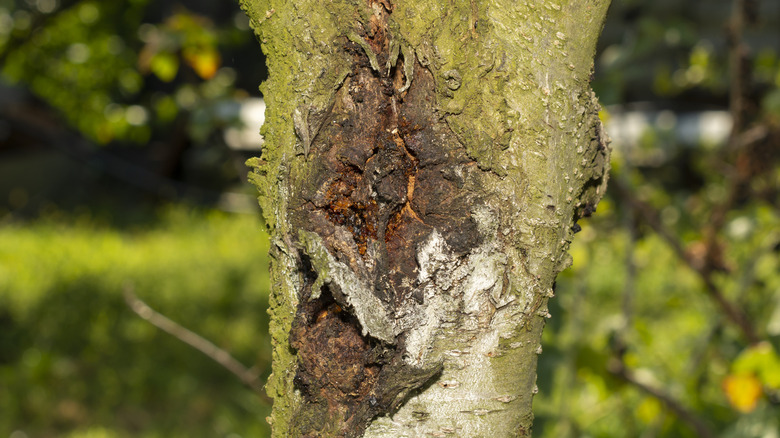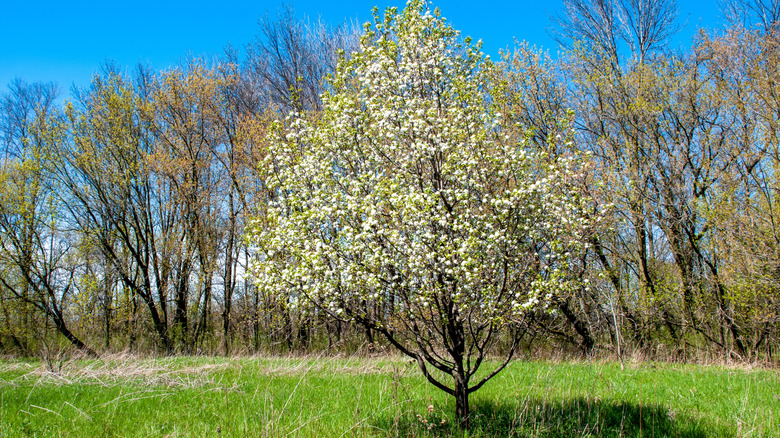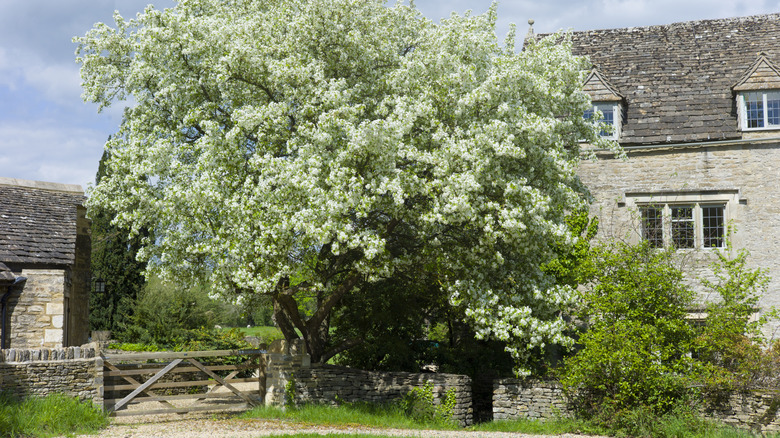Signs That Tree Removal Is The Right Decision For Your Yard
It's irrefutable that trees add value to your property. These majestic sentinels improve your property's aesthetics, reduce stormwater runoff bills, better regulate temperatures and air quality, and lower traffic noise. Plus, they add ecological value by attracting birds and wildlife. But when trees begin showing signs of decay, disease, or old age, removing them can become necessary. This is especially important when over half of the tree is already in decline, as it has little-to-no chance of making a recovery. Other times, trees may need to go if they've suffered significant storm damage or become weak due to environmental stressors like drought and soil compaction. After all, you don't want to lose sleep over tree limbs breaking suddenly, crashing over the driveway, interfering with power lines, or falling on your home.
If you're unsure whether a tree is posing a danger on your property, it can help to consult a certified arborist, as they can make an accurate assessment of the tree's condition. In rare cases, you might have to remove healthy trees because they're invasive, messy, or interfere with your home's foundation. That being said, not all dying or dead trees warrant immediate removal. For instance, if they're tucked in a corner of a large property where limbs breaking (or even the entire tree coming down) is unlikely to imperil anyone, you may be able to leave them be. Hardwood trees are a prime example, as they take years to deteriorate, all the while serving as wildlife habitats for woodpeckers, owls, and songbirds. As you can see, there's a lot to consider before you chop down a tree. Ahead, we list the telltale signs that merit tree removal, so you can start to weigh up which trees should go versus which can stay.
The tree is planted too close to your home
It's easy to underestimate how far to plant a tree from your home, and lots of people make the mistake of placing large trees too close to structures. When it comes to tree placement, there are usually multiple factors at play in a residential property. For starters, you don't want mature canopies overhanging and damaging your roofs, eaves, or garage doors. Nor do you want them blocking any desirable sightlines. Even when planted for shade, trees shouldn't be closer than 20 feet from your house, though small trees can still be planted slightly closer at 15 feet. Removing a shade tree is a tough decision, but if its boughs are overhanging your home, it may need to go. Similarly, pay attention to potential fire risks. Small trees under 10 inches wide or supporting thinning crowns can serve as "ladder fuels" during fires. Removing these to create more space between larger trees can help reduce fire risks.
Tree roots are another thing to consider. When roots are strapped for space (or grow in very compacted soil), they might form a shallow network that makes the entire tree less stable. Roots may also work their way into foundation cracks or drainage systems, causing costly damage over time. As you probably already gathered, trees are one set of plants you shouldn't grow right next to your house, and species with vigorous root systems pose particular danger to foundations and plumbing pipes and should be removed. You also might want to remove trees that are less than 5 feet away from hardscaping elements such as walkways and driveways, as they might get displaced by the roots over time.
The tree has taken excessive trunk damage
Tree stability and strength largely ride on the trunk's health. If the main trunk takes damage, this can significantly weaken the tree and impact its ability to transport nutrients. Thus, if you notice a massive vertical fracture or split running down the trunk's length, perhaps after lightning or a hurricane, take it as a sign to call a tree service company. If left, decay may settle in, weakening the tree even further and increasing the risk of it falling.
Similarly, you should be concerned if an accidental brush with lawn care equipment, tractors, or road traffic causes lower trunks to crack open or prompts bark splits. Frost cracking, girdling roots, and drought stress may also cause trunk damage, as can mulching too close to trees (this can spur rot). Although trees will try to seal the cracks by compartmentalizing the area and building more tissue around it, they may not always be successful when the damage is severe. Generally, when damage exceeds 25% of the tree's total width, it's unlikely to be remedied and removal is probably necessary.
The tree has lost a lot of large limbs or has bad bark inclusion
Another sign that removal is the best decision is if a tree has lost a significant amount of limbs. Although trees can generally tolerate losing their smaller branches without permanently impairing their health, this isn't the case for codominant or larger limbs. If big limbs break off, this can cause significant damage to the trunk. One of the reasons why trees lose their main branches is bark inclusions. Bark inclusion happens when a branch grows right up against another branch or the trunk, eventually connecting together, with a section of bark still remaining within the tree tissue. This creates weak spots and can cause branches to break off (or even trunks to split) in strong winds. Sealing resulting wounds is difficult even after pruning. Large areas of trunk damage makes trees highly vulnerable to opportunistic insects and disease-causing microorganisms, and it's generally best to remove the entire tree instead of wasting resources trying to save it.
Genetics can also play a role in how easily trees lose limbs in a storm. Weak-limbed species like willows (Salix spp.) and poplars (Populus spp.) aren't as good as hardwood trees when dealing with wind and sleet action. Thanks to this, they might wind up as contenders for removal.
Besides being vulnerable to pests, disease, and rot, trees that have lost large limbs are also likely to move their resources into quickly sprouting new limbs. Unfortunately, such quick growth is often weak and tender, making them even more susceptible to environmental stressors and natural disasters in the long run. In short, if a hardwood tree loses over half of its limbs or crown (or 30% for pines), it should be removed. Likewise, if the tree's dead branches (that don't have any green buds) are concentrated on one side, it's best to get rid of it before it topples over — particularly if over 70% of the crown on one side is lost.
The tree's roots are beyond saving
If over half of the tree's roots are already dead, it's time for it to go. But how do you figure that out? Root damage is more of a slow burn, often taking several years to become fully apparent. Initial signs include bud and twig die-back, fewer leaves, and early onset of fall colors, culminating eventually in slow growth. This happens because the tree can't access adequate nutrients. However, if the roots have died only on one side, perhaps owing to mechanical damage from lawnmowers and rototillers, digging or earthworks, the signs will be focused on the tree section directly corresponding to it. Poor gardening practices, such as overwatering and excessive fertilization, can also harm tree roots, advancing rot and decay. Prolonged drought stress destroys roots as well. Once they're damaged, the roots can no longer adequately anchor the tree in the soil.
If more than a third of a tree's structural roots have died, the tree is at heightened risk of blowing over, making it unsafe to have in a yard. You may also want to keep your eyes peeled for girdling roots. These grow circularly around the tree trunk at the soil level and should be removed before they strangle and kill the tree. If the stem is badly girdled and unlikely to recover, you might want to consider removing the tree before it becomes a safety hazard.
The tree is diseased or infested
Considering the lifespan of trees, them falling afoul of pests and diseases occasionally is only reasonable. Regrettably, not all trees can brave through such infestations, necessitating their removal. For instance, oak wilt's fungal spores interfere with trees' water uptake, causing premature demise, sometimes within weeks. As a result, any oak tree whose crown is exhibiting signs of sudden withering must generally be eliminated — crown damage beyond 30% is the cut-off point, denoting the tree is past repair. Similarly, if you have ash trees, and don't take steps to prevent invasive emerald ash borers from destroying your trees, the insects can kill the top third of crowns. This is followed by branch die-back, and death of the tree in three years. Around this time, you might also find epicormic shoots growing out of your ash trees. Essentially, epicormic shoots are small suckers that sprout from a tree's trunk or branches to make up for a loss of leaves.
Sometimes, you may also find mushrooms (like Armillaria) growing around your tree's base, indicating the presence of root fungi. Some common mushrooms may grow on tree limbs, indicating branch rot. These branches should be removed, and the tree evaluated for overall health. If rot is widespread you'll need to consider removal. It also helps to find out if the specific tree species is good at compartmentalizing infected areas (to block fungi), such as oaks and elms, before you finalize your tree removal decision.
The tree has grown hollow
Removal may also be necessary if you're guilty of employing the common trimming practice that's actually killing your trees: topping. Topping is a technique where large amounts of tree parts are unceremoniously cut, leaving bare branches and stubs in their stead. This opens the gateway to rotting microbes, kickstarting the process of internal decay. To fight them off, the trees try to seal away the organisms and build new tissues around the infected area, resulting in tree hollows and cavities. Such scenarios are also common if the tree loses any major branches due to wind action or mechanical damage.
Fortunately, being hollow doesn't immediately sentence trees to be axed. Certain species, including hardwoods and conifers, can often grow sturdy wood around damaged tissues to ensure their structural integrity. Indeed, unless they've lost over 70% of their cross-sectional area, in addition to multiple cavities, they can keep standing. But if the concerned tree is a softwood, it's best to cut it down, especially if it's in an area of your yard where you spend a lot of time. Another golden rule is to spare trees that have grown 2- to 4-inch thick wood around the trunk, as they'll have sufficient structural integrity. Otherwise, remove them.
The tree is leaning to one side
While you can let certain trees (such as old oaks and Douglas firs) off the hook for wanting to lean in the direction of maximum sunlight, not all trees can be meted out the same treatment. Unless the tree has been growing and thriving leaning in a particular direction for years or has the capacity to quickly generate growth to counterbalance its leaning (common in hardwoods and conifers), any sudden downward incline should prompt an inspection. This usually transpires for trees growing in wet or waterlogged soils, on slopes, or those that have recently endured a storm event.
With that said, if your tree feels off-kilter, having moved at least 30 degrees away from its vertical position, hire a certified arborist to look into its condition. Chances are that its root system is heaving out of the ground or rotting away. In other words, the tree isn't secure in its site and should be chopped down, especially if it's within striking distance of streets, your home, a fence, shed, or other structure. Trees with little foliage on their lower branches are also in the running for removal, as they're unlikely to support their weight for long once they begin leaning sideways. This is common where clusters of trees have been thinned, and the remaining ones are spindly and start to lean.
The tree has outstripped the utility clearance
Another instance where you should immediately elect to replace your yard tree is if it interferes with electricity lines. Most electricity outages — both generally and after storms — are an outcome of weak limbs splitting apart from trees and breaking the utility line. Even when the trees meet the necessary clearances, they may pose a danger in the wet season. That's because electricity can arc a whopping 10 feet down to wet leaves and be conducted into the ground, leaving the area marred in its wake. Besides, several states, including Florida, have legislated that only small trees (which typically max out at 25 feet on maturity) should be planted underneath utility lines. Therefore, planting large trees (like oaks, maples, and pines) could put you in direct conflict with the law.
So, get rid of any medium or large-size trees not meeting the utility clearances, or at the very least, thin out their canopies to minimize interference with power lines. When planting new trees, stick to small species like dwarf fruit trees, hawthorns (Crataegus spp.), and redbuds (Cercis canadensis) that remain under 25 feet, and relegate other bigger trees to spots at least 20 feet away from any utility lines.
The tree is invasive in your area
Another solid reason to chop down a tree growing in your yard is if it's invasive. As you're probably aware, invasive trees are exotic plants that don't originally belong to the country, but were introduced for ornamental or agricultural value. However, they tend to escape their boundaries into natural and wild areas and outcompete native vegetation — usually because of profuse seeding. This is problematic as it deprives native pollinators, birds, and wildlife of natural habitat and food resources.
To avoid worsening the problem, you must remove invasive plant species from your lawn and garden. Common examples include Bradford pear (Pyrus calleryana), Chinese tallow (Triadica sebifera), mimosa (Albizia julibrissin), chinaberry (Melia azedarach), Norway maple (Acer platanoides), and tree of heaven (Ailanthus altissima). Keep in mind that invasiveness of non-native trees varies by state. If you aren't sure whether your yard is harboring an invasive tree, get in touch with your local state extension office or CISMA (Cooperative Invasive Species Management Areas) with appropriate photos and description of the species. After removing, replant the area with, preferably, a tree native to your region.
The tree is messy in the landscape
Some trees, for all their majestic charm, exact the price of high maintenance. For instance, hawthorn trees (Crataegus spp.) provide ample shade and serve as a crucial winter food source (those red berries!) for a bevy of birds like chickadees and robins. Unfortunately, they also attract their fair share of insects, including leafminers, borers, and lace bugs. Worse, they can't be planted alongside another juniper species like crabapples (Malus spp.), quince (Cydonia oblonga), or eastern red cedar (Juniperus virginiana) without endangering the copse to cedar apple rust, a fungal disease. You can similarly expect pear (Pyrus spp.) trees to turn your yard into a wasp zone with their fruit droppings. Other trees like glossy privet (Ligustrum lucidium) and white mulberry (Morus alba) produce fruits that can stain driveways, decks, etc. Mimosa (Albizia julibrissin), eucalyptus (eucalyptus spp.), and blackwood acacia (Acacia melanoxylon) can be equally problematic, as they litter the ground with shed leaves and twigs.
These trees aren't bad (and can have their own sets of benefits, like feeding native wildlife). Whether you want them in your yard or not entirely comes down to how much time you have for maintenance. You might want to bail on the idea of growing certain types of fruit-bearing trees if frequent pest and disease treatments will be necessary to suitably maintain them and you don't feel up to the task. Or, if the constant cleanup outweighs the benefits of creating ecological value, removing a very messy tree could make practical sense for your yard.










